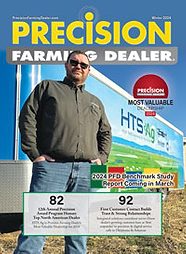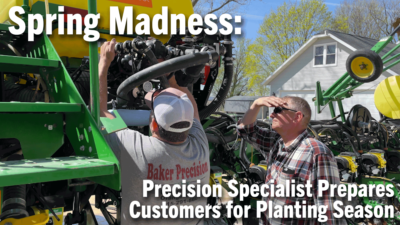Manufacturers update cabs with integrated auto-guidance to improve performance and simplify the sales process for dealers.
For some time now, farm equipment dealers have had the option of selling combines, tractors and sprayers with factory-installed auto-guidance capabilities.
But only recently, has the technology been adapted to windrowers, largely because the equipment is unlike any other to steer.
“It’s probably one of the hardest, if not the hardest piece of equipment to steer,” says Trevor Mecham, Case IH Advanced Farming Solutions marketing manager. “I would put that even up against implement steering. It’s really quite an art form.”
In an article published in the July/August 2012 issue of Farm Equipment, some dealers and precision experts noted that the partnering of precision guidance and windrowers is still a work in progress — and often a tough sell — partly because of the cost and complexity of getting components to work together.
But manufacturers are moving toward comprehensive precision steering systems in windrowers that put functionality and performance on par with other farm equipment.
This year, both Case IH and John Deere launched new windrower models featuring integrated auto-steer capabilities, advancing beyond what had been traditionally an aftermarket technology option on the equipment.
“When you look at the precision steering industry over the last 15 years, how many various ways and applications have people been trying to steer these machines?” Mecham says. “Aftermarket installation in windrowers was pretty costly and not always as efficient as we’d want it to be.”
Case IH’s new WD3 II windrower, introduced this past summer, offers factory installed auto-guidance, managed through the AFS Pro 700 control center. Integrated auto-steer on windrowers gives dealers more sales ammunition in areas where hay and forage harvesting is prominent, Mecham says.
“Accuracy is very important and having better integration allows those machines to respond quicker on tight turns and reduce overlap,” he says. “This is a big priority for our market in western Canada and parts of the Pacific Northwest and California where’s there’s high adoption of the hay and forage business.”
Deere debuted the W235 model self-propelled windrower at its annual new product launch event this summer and Precision Farming Dealer talked with James Petersen, marketing representative about what the upgrades mean for dealers.
His emphasis was on the efficiency that the systems offer, which dealers can leverage as a selling point to customers. The new models, available in 2014, upgrade from a mechanical to a hydraulic drive, and combined with auto-steer allow farmers to cover more hay acres in a day.
“Our dealers have been asking for this machine and we’re seeing speeds up to 17 mph, compared to about 8 mph in the past,” Petersen says. “Even if farmers run at 10 mph using a 16 foot platform, that’s an increase of 4 acres per hour of productivity and in a 10 hour day, that 40 more acres covered.”
Another potential benefit for dealers is the option of telematics and remote support to diagnose in-field problems, Petersen says. Although still a relatively new technology overall, Deere will include it’s JDLink telematics system on the new windrowers, allowing farmers to monitor their machines remotely, and also allow their dealers to track performance.
“The guidance technology is familiar to a lot of our dealers, because they’ve been selling it in combines, tractors and sprayers, but today, it’s all about the data,” Petersen says. “Remote display access can be a huge timesaver, because the dealer can log into the customer’s machine, diagnose the problem or help change a monitor setting and save a service trip.”







Post a comment
Report Abusive Comment